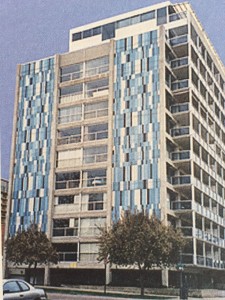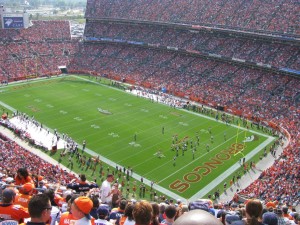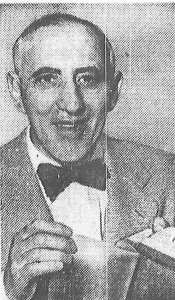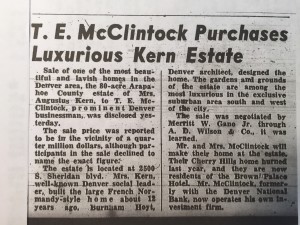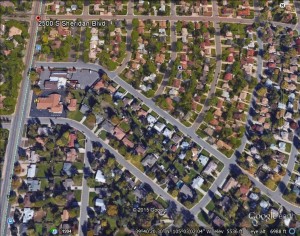Story
Part IV -- 888 Logan Street
Home to the Prominent
Last week, we learned about a psychiatrist, a lawyer, an oil man, and an industrialist who all lived at 888 Logan Street, an apartment building in Denver’s Capitol Hill neighborhood that was once said to be, “the most luxurious apartment house ever built in Denver.” Constructed in 1959, the building is of midcentury modern design, a style created in the 1950s and portions of the preceding and following decades. The 888 Logan Street building exemplifies midcentury modern style with its clean, unadorned lines and large expanses of glass.
The living rooms and bedrooms of the units have one wall of floor-to-ceiling, wall-to-wall glass that melds indoors and out. Interior walls are smooth and textureless with no baseboards. Also, the concrete used in the flat slab construction is a very typical material for modern style. The designer was well-known architect William Muchow, who also designed the 16-story, black glass Park Central complex at 16th Street and Market and the 12-story Blue Cross/Blue Shield Building at 8th Avenue and Broadway—among others.
But what of the prominent residents when 888 Logan Street was new? This week, we start off with a bang: one of the Broncos' biggest fans ever!
Charlie Goldberg
Charlie Goldberg (1909–2001) was the wealthy owner of the Barnett Company, a conglomerate of construction and steel companies. But he was best known for being the number one Denver Broncos get-it-done man and devoted supporter. A 1984 Rocky Mountain News article states that he had never missed a home game since the team was formed in 1960, and he had missed very few away games. Having priority number 39, the football players referred to him as “Mr. Bronco” because he sent them crates of oranges, sometimes rode with them on the team plane, and founded the Quarterback Club. Charlie created Orange Sunday on October 17, 1971, when he got permission, if he footed the bill, to pass out a strip of orange cloth to every fan. He bought all the orange cloth he could find in Denver, had it cut up, and had the Quarterback Club distribute it at the gates. That was the birth of Orange Sunday and the birth of the towel-waving craze. He copyrighted the slogan “Big Orange—How Sweet It Is.”
He was instrumental in raising funds to expand Bears Stadium to over 50,000 seats—a requirement for Denver being included in the AFL-NFL merger. The expansion was completed in 1968 and the stadium renamed Mile High Stadium. Charlie also took charge of a drive for a new Broncos stadium in 1997–98. He was one of three others besides Pat Bowlen on the first Ring of Fame Selection Committee. With Jim McNally, he authored Broncos! How Sweet It Is! just before his death. (Apartment 9I)
Henry G. Frankel
Henry G. Frankel (1891–1985) was from a Denver pioneer family as his maternal grandparents (Mr. and Mrs. Henry Kline) came to Denver in the 1860s. Frankel was President of Frankel Manufacturing Company, an office-supply business started in 1906 at 1720 Arapahoe Street by his father. Frankel took over the business in 1909, putting the firm on a world-wide scale with several inventions. Among those inventions were the first pure silk typewriter ribbons, the first protein duplicating stencils, and the static-free stencil. By 1958 Frankel Manufacturing had (in Denver) the world’s largest factory for the manufacture of duplicating supplies, shipping to every city and county in the United States as well as Europe, South America, and Asia. At his death at age 93, Frankel Manufacturing was a $35-million-a-year business.
He had a law degree from the University of Denver and was admitted to the Colorado Bar, but never practiced law. A founder and trustee of Rose Medical Center, Frankel also was the founder and first president of the Allied Jewish Council and the founder and president of Congregation Emanuel. (Apartment 11E)
Thomas E. McClintock
Edith B. McClintock, widow of T.E. McClintock (1888–1950), after his death moved from their large estate to live at 888 Logan Street. Mr. McClintock was a banker who started in the business by working with his father in the farm mortgage banking business. In 1914 he was manager of W.C. McClintock & Sons, a farm loan company, in Havre MT, 35 miles south of the Canadian border. In WWI he fought in France with the 247th Machine Gun Battalion. He, his wife, and their three children came to Colorado in 1928.
A 1946 Rocky Mountain News article says that McClintock was formerly with the Denver National Bank, but now operated his own investment firm. That year he paid a reported $250,000 ($3.2 million in 2015 dollars) for a house, designed by Burnham Hoyt, and 80-acre estate at 2500 S. Sheridan Boulevard. Their Cherry Hills home having burned the previous year, he and his wife were living at the Brown Palace Hotel. Today the 80 acres (equivalent to 16 Denver city blocks) are filled with over 100 homes, two churches, and a daycare center. He must have owned mineral rights in Weld County, as there are several 2014 references on the internet regarding royalty payments to the T.E. McClintock Trust for the benefit of his daughters Mary and Elizabeth. (Apartment 11D)
Did you know? The core of the work of Denver architect Burnham Hoyt (1887–1960) was designing homes for Denver's wealthy. But he also designed Red Rocks Amphitheater, incorporating the natural rock formations, and designed the original 1955 portion of the Denver Public Library.
Hannah Levy
Hannah Levy (1905–1984) was co-owner with her brother Jack of Fashion Bar, which at the time of her death was Colorado’s largest privately-owned store chain. In 1933 they opened a Hosiery Bar store at 1534 Curtis Street, and three years later, after acquiring the neighboring dress shop, changed the name to Fashion Bar. In 1975 they opened a new division named after her—Hannah’s, and that year opened a men’s shop called L’Uomo. At the height of the business there were 83 women’s apparel stores in Colorado and Cheyenne, Wyoming.
One of the country’s best-known women retailers, she was recognized for being a generous supporter of Rose Medical Center, Denver Symphony, Denver Art Museum, and Denver Center for the Performing Arts. Because of her support of civic organizations and the Jewish community, she received the American Jewish Congress Humanitarian Service award. She was posthumously inducted into the Colorado Business Hall of Fame in 2001. (Apartment 10I)
Next week in our last installment: A professor, a business man, and a manufacturer—and the influence of all of 888 Logan Street's residents on today.

